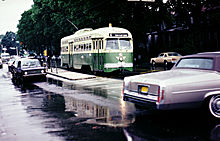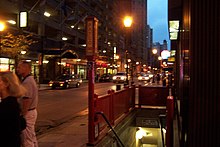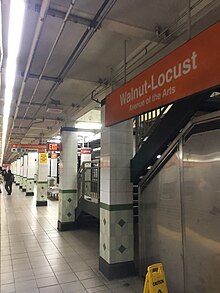
A | B | C | D | E | F | G | H | CH | I | J | K | L | M | N | O | P | Q | R | S | T | U | V | W | X | Y | Z | 0 | 1 | 2 | 3 | 4 | 5 | 6 | 7 | 8 | 9
| Southeastern Pennsylvania Transportation Authority (SEPTA) | |||
|---|---|---|---|
 | |||
| Overview | |||
| Area served | Philadelphia and the surrounding Delaware Valley, including New Castle County, Delaware, and South Jersey | ||
| Locale | Delaware Valley | ||
| Transit type | |||
| Number of lines | 196 | ||
| Number of stations | 290 | ||
| Daily ridership | 450,000 | ||
| Annual ridership | 223.5 million (2020)[1] | ||
| Chief executive | Leslie Richards (General Manager) | ||
| Headquarters | 1234 Market Street, Philadelphia, Pennsylvania, U.S. | ||
| Website | septa | ||
| Operation | |||
| Began operation | November 1, 1965 | ||
| Number of vehicles | 2,897 (2018)[3] | ||
| |||
The Southeastern Pennsylvania Transportation Authority (SEPTA) is a regional public transportation authority[4] that operates bus, rapid transit, commuter rail, light rail, and electric trolleybus services for nearly four million people in five counties in and around Philadelphia, Pennsylvania. It also manages projects that maintain, replace and expand its infrastructure, facilities and vehicles.
SEPTA is the major transit provider for Philadelphia and the four surrounding counties, Delaware, Montgomery, Bucks, and Chester. It is a state-created authority, with the majority of its board appointed by the five Pennsylvania counties it serves.[5] While several SEPTA commuter rail lines terminate in the nearby states of Delaware and New Jersey, additional service to Philadelphia from those states is provided by other agencies: the PATCO Speedline from Camden County, New Jersey is run by the Delaware River Port Authority, a bi-state agency; NJ Transit operates many bus lines and a commuter rail line to Philadelphia's Center City; and DART First State runs feeder bus lines to SEPTA stations in the state of Delaware.
SEPTA has the sixth-largest U.S. rapid transit system by ridership, and the fifth-largest overall transit system in the U.S. with about 302 million annual unlinked trips as of fiscal year 2018.[6] It controls 290 active stations, over 450 miles (720 km) of track, 2,350 revenue vehicles, and 196 routes.[7] It also oversees shared-ride services in Philadelphia and ADA services across the region, which are operated by third-party contractors, Amtrak, and NJ Transit.
SEPTA is the only U.S. transit authority that operates all of the five major types of terrestrial transit vehicles: regional commuter rail trains, rapid transit subway and elevated trains, light rail trolleys, trolleybuses, and motorbuses. This title was shared with Boston's Massachusetts Bay Transportation Authority, which also runs ferryboat service, until trolleybuses in Greater Boston were discontinued in 2023.[8]
History
Formation

SEPTA was created by the Pennsylvania legislature on August 17, 1963, to coordinate government funding to various transit and railroad companies in southeastern Pennsylvania. It commenced on February 18, 1964.[9]
On November 1, 1965, SEPTA absorbed two predecessor agencies:
- The Passenger Service Improvement Corporation (PSIC), was created on January 20, 1960, to work with the Reading Company and Pennsylvania Railroad to improve commuter rail service and help the railroads maintain otherwise unprofitable passenger rail service.
- The Southeastern Pennsylvania Transportation Compact (SEPACT), was created September 8, 1961, by the City of Philadelphia and the Counties of Montgomery, Bucks, and Chester to coordinate regional transport issues.
By 1966, the Reading Company and Pennsylvania Railroad commuter railroad lines were operated under contract to SEPTA. On February 1, 1968, the Pennsylvania Railroad merged with the New York Central railroad to become Penn Central, only to file for bankruptcy on June 21, 1970. Penn Central continued to operate in bankruptcy until 1976, when Conrail took over its assets along with those of several other bankrupt railroads, including the Reading Company. Conrail operated commuter services under contract to SEPTA until January 1, 1983, when SEPTA took over operations and acquired track, rolling stock, and other assets to form the Railroad Division.
Subsequent expansion



Like New York City's Second Avenue Subway, the original proposal for the Roosevelt Boulevard Subway dates to 1913, but construction has remained elusive. Instead, after completing the Market–Frankford Line in and around the city stagnated until the early 2000s.
On September 30, 1968, SEPTA acquired the Philadelphia Transportation Company (PTC), which operated a citywide system of bus, trolley, and trackless trolley routes, the Market–Frankford Line (subway-elevated rail), the Broad Street Line (subway) and the Delaware River Bridge Line (subway-elevated rail to City Hall, Camden, NJ) which became SEPTA's City Transit Division. The PTC had been created in 1940 with the merger of the Philadelphia Rapid Transit Company (formed in 1902) and a group of smaller, then-independent transit companies operating within the city and its environs.
On January 30, 1970, SEPTA acquired the Philadelphia Suburban Transportation Company, also known as the Red Arrow Lines, which included the Philadelphia and Western Railroad (P&W) route now called the Norristown High-Speed Line, the Media and Sharon Hill Lines (Routes 101 and 102) and several suburban bus routes in Delaware County. Today, this is the Victory Division, though it is sometimes referred to as the Red Arrow Division.
On March 1, 1976, SEPTA acquired the transit operations of Schuylkill Valley Lines, which is today the Frontier Division. Meanwhile, SEPTA gradually began to take over the Pennsylvania Railroad and Reading Company commuter trains. SEPTA primarily sought to consolidate the formerly-competing services, leading to severe cutbacks in the mid-1980s.[10] Subsequent proposals have been made to restore service to Allentown, Bethlehem, West Chester, and Newtown, with support from commuters, local officials and pro-train advocates.
SEPTA's planning department focused on the Schuylkill Valley Metro, a "cross-county metro" that would re-establish service to Phoenixville, Pottstown, and Reading without requiring the rider to go into Philadelphia.[11][12] However, ridership projections were dubious, and the Federal Railroad Administration refused to fund the project.[13][14]
Many derelict lines under SEPTA ownership have been converted to rail trails, postponing any restoration proposals for the foreseeable future.[15] Proposals have also been made for increased service on existing lines, including later evenings and Sundays to Wilmington, Delaware and Newark in Delaware. Maryland's MARC commuter rail system is considering extending its service as far as Newark, which would allow passengers to connect directly between SEPTA and MARC. Other recent proposals have focused on extending and enhancing SEPTA's other transit services. Senator Bob Casey has supported recent proposals expanding the Broad Street Line to the Philadelphia Naval Shipyard.[16] As of December 2017[update], SEPTA had completed an Environmental Impact Statement to extend the Norristown High Speed Line to the King of Prussia area.[17][18]
In September 2021, SEPTA proposed rebranding their rail transit services, the Market–Frankford Line, Broad Street Line, Subway–Surface trolley lines, Norristown High-Speed Line, Route 15 trolley, and Routes 101 and 102 trolleys) as the "SEPTA Metro", in order to make the system easier to navigate.[19][20] Under this proposal, new maps, station signage, and line designations would be created. Under the proposed nomenclature, trunk lines would receive a letter and a color, with services having a numeric suffix and service name, to make wayfinding easier.[21] Services on the current Market–Frankford Line, for instance, would be called "the L" and colored blue, with local service becoming the "L1 Market–Frankford Local".[22] SEPTA budgeted $40 million to June 2023 for the rebranding.[23] SEPTA upgraded its website in late 2023[24][25] in advance of the planned rollout of SEPTA Metro in 2024.[26]
Governance
At its founding in 1968, the board had 11 members. In 1991 the state legislature added four additional members, giving themselves more influence on the board.[27]
SEPTA is governed by a 15-member board of directors:
- The City of Philadelphia appoints two members: one member is appointed by the Mayor, the other by the City Council President. These two board members can veto any item that is approved by the full SEPTA board because the city represents more than two-thirds of SEPTA's local funding, fare revenue, and ridership. However, the veto may be overridden with the vote of at least 75% of the full board within 30 days.
- Bucks, Chester, Delaware, and Montgomery counties appoint two members each. These members are appointed by the county commissioners in Bucks, Chester, and Montgomery and by the county council in Delaware.
- The majority and minority leaders of the two houses of the Pennsylvania State Legislature (the Senate and the House of Representatives) appoint one member each, for a total of four members.
- The governor appoints one member.
The members of the SEPTA Board as of March 2023[update] are:[28]
| Name | Appointed by |
|---|---|
| Michael A. Carroll | City of Philadelphia |
| Deborah Mahler | |
| Kenneth Lawrence Jr. (Vice-chair) | Montgomery County |
| Robert D. Fox | |
| Pasquale T. Deon Sr. (Chairman) | Bucks County |
| John F. Cordisco | |
| Kevin L. Johnson | Chester County |
| Marian D. Moskowitz | |
| Daniel R. Muroff, Esq. | Delaware County |
| Mark H. Dambly | |
| Scott C. Freda | Pennsylvania Governor |
| Thomas J. Ellis | Senate Majority Leader |
| William J. Leonard | Senate Minority Leader |
| Esteban Vera Jr. | House Majority Leader |
| Martina White | House Minority Leader |
The day-to-day operations of SEPTA are handled by the general manager, who is appointed and hired by the board of directors. The general manager is assisted by nine department heads called assistant general managers.
The present general manager is Leslie Richards. Past general managers include Jeffrey Knueppel, Joseph Casey, Faye L. M. Moore, Joseph T. Mack, John "Jack" Leary, Louis Gambaccini, and David L. Gunn. Past acting general managers include James Kilcur and Bill Stead.
SEPTA is a member of the Northeast Corridor Commission, a federal commission on Northeast Corridor rail service.
Ridership
In 2020, annual ridership was 223.5 million individual rides. 17.1 million were rides on SEPTA's suburban network. 26.3 million were rides on SEPTA's "regional rail" network. 180.1 million were rides on SEPTA's "city transit" network.[1]
Ridership had decreased 13% from 2014 to 2019 due to many factors. Some explanations mentioned by SEPTA for this decrease are "increased competition, structural changes in ridership patterns, and moderate gas prices." The 24% decrease in ridership from 2019 to 2020 was mostly attributable to the impact of government-implemented lock-downs in response to the COVID-19 pandemic that began in mid-March 2020.[1]
Routes
SEPTA's public services consist of three main networks: SEPTA Metro, bus operations, and regional rail.[29]
SEPTA Metro
As of 2024[update], SEPTA is in the process of rolling out SEPTA Metro, a unified brand for its urban rail transit services, including rapid transit, trolley, and interurban services.[29][30] SEPTA has the largest trolley system in the United States.[31]
| Line | Train | Pre-Metro name | Description | Transit type | West / North terminus | East / South terminus | Operating hours | Weekday ridership (Fall 2023)[32] |
|---|---|---|---|---|---|---|---|---|
| Market–Frankford Line | Market Street Elevated
Market Street Subway Kensington–Frankford Elevated |
Rapid transit | 69th Street Transit Center | Frankford Transit Center | 5:00 a.m. to 12:00 a.m.
Overnight "Owl" shuttle bus from 12:00 a.m. to 5:00 a.m. |
107,651 | ||
| Broad Street Line | Broad Street Subway Local | Fern Rock Transit Center | NRG | 79,155 | ||||
| Broad Street Subway Express | Walnut–Locust
NRG (limited) |
Weekdays: 5:30 a.m. to 9:30 a.m. and 2:00 p.m. to 6:30 p.m. | ||||||
| Broad–Ridge Spur | Fern Rock Transit Center
Olney Transit Center (limited) |
8th–Market | Weekdays: 5:00 a.m. to 9:00 p.m.
Saturdays: 6:00 a.m. to 9:00 p.m. | |||||
| Route 10 | Lancaster Avenue trolley line | Trolley (subway-surface) | 63rd–Malvern / Overbrook | 13th Street | 24 hours per day | 8,302 | ||
| Route 34 | Baltimore Avenue trolley line | 61st–Baltimore / Angora | 4:30 a.m. to 2 a.m. | 8,800 | ||||
| Route 13 | Chester Avenue trolley line | Yeadon
Darby Transit Center (limited) |
Zdroj:https://en.wikipedia.org?pojem=SEPTA

